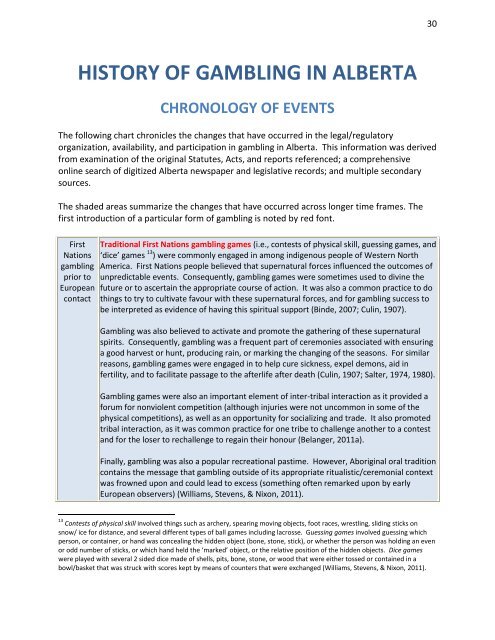gambling in alberta - Research Services - University of Lethbridge
gambling in alberta - Research Services - University of Lethbridge
gambling in alberta - Research Services - University of Lethbridge
You also want an ePaper? Increase the reach of your titles
YUMPU automatically turns print PDFs into web optimized ePapers that Google loves.
HISTORY OF GAMBLING IN ALBERTA<br />
CHRONOLOGY OF EVENTS<br />
The follow<strong>in</strong>g chart chronicles the changes that have occurred <strong>in</strong> the legal/regulatory<br />
organization, availability, and participation <strong>in</strong> <strong>gambl<strong>in</strong>g</strong> <strong>in</strong> Alberta. This <strong>in</strong>formation was derived<br />
from exam<strong>in</strong>ation <strong>of</strong> the orig<strong>in</strong>al Statutes, Acts, and reports referenced; a comprehensive<br />
onl<strong>in</strong>e search <strong>of</strong> digitized Alberta newspaper and legislative records; and multiple secondary<br />
sources.<br />
The shaded areas summarize the changes that have occurred across longer time frames. The<br />
first <strong>in</strong>troduction <strong>of</strong> a particular form <strong>of</strong> <strong>gambl<strong>in</strong>g</strong> is noted by red font.<br />
First<br />
Nations<br />
<strong>gambl<strong>in</strong>g</strong><br />
prior to<br />
European<br />
contact<br />
Traditional First Nations <strong>gambl<strong>in</strong>g</strong> games (i.e., contests <strong>of</strong> physical skill, guess<strong>in</strong>g games, and<br />
‘dice’ games 13 ) were commonly engaged <strong>in</strong> among <strong>in</strong>digenous people <strong>of</strong> Western North<br />
America. First Nations people believed that supernatural forces <strong>in</strong>fluenced the outcomes <strong>of</strong><br />
unpredictable events. Consequently, <strong>gambl<strong>in</strong>g</strong> games were sometimes used to div<strong>in</strong>e the<br />
future or to ascerta<strong>in</strong> the appropriate course <strong>of</strong> action. It was also a common practice to do<br />
th<strong>in</strong>gs to try to cultivate favour with these supernatural forces, and for <strong>gambl<strong>in</strong>g</strong> success to<br />
be <strong>in</strong>terpreted as evidence <strong>of</strong> hav<strong>in</strong>g this spiritual support (B<strong>in</strong>de, 2007; Cul<strong>in</strong>, 1907).<br />
Gambl<strong>in</strong>g was also believed to activate and promote the gather<strong>in</strong>g <strong>of</strong> these supernatural<br />
spirits. Consequently, <strong>gambl<strong>in</strong>g</strong> was a frequent part <strong>of</strong> ceremonies associated with ensur<strong>in</strong>g<br />
a good harvest or hunt, produc<strong>in</strong>g ra<strong>in</strong>, or mark<strong>in</strong>g the chang<strong>in</strong>g <strong>of</strong> the seasons. For similar<br />
reasons, <strong>gambl<strong>in</strong>g</strong> games were engaged <strong>in</strong> to help cure sickness, expel demons, aid <strong>in</strong><br />
fertility, and to facilitate passage to the afterlife after death (Cul<strong>in</strong>, 1907; Salter, 1974, 1980).<br />
Gambl<strong>in</strong>g games were also an important element <strong>of</strong> <strong>in</strong>ter-tribal <strong>in</strong>teraction as it provided a<br />
forum for nonviolent competition (although <strong>in</strong>juries were not uncommon <strong>in</strong> some <strong>of</strong> the<br />
physical competitions), as well as an opportunity for socializ<strong>in</strong>g and trade. It also promoted<br />
tribal <strong>in</strong>teraction, as it was common practice for one tribe to challenge another to a contest<br />
and for the loser to rechallenge to rega<strong>in</strong> their honour (Belanger, 2011a).<br />
F<strong>in</strong>ally, <strong>gambl<strong>in</strong>g</strong> was also a popular recreational pastime. However, Aborig<strong>in</strong>al oral tradition<br />
conta<strong>in</strong>s the message that <strong>gambl<strong>in</strong>g</strong> outside <strong>of</strong> its appropriate ritualistic/ceremonial context<br />
was frowned upon and could lead to excess (someth<strong>in</strong>g <strong>of</strong>ten remarked upon by early<br />
European observers) (Williams, Stevens, & Nixon, 2011).<br />
13 Contests <strong>of</strong> physical skill <strong>in</strong>volved th<strong>in</strong>gs such as archery, spear<strong>in</strong>g mov<strong>in</strong>g objects, foot races, wrestl<strong>in</strong>g, slid<strong>in</strong>g sticks on<br />
snow/ ice for distance, and several different types <strong>of</strong> ball games <strong>in</strong>clud<strong>in</strong>g lacrosse. Guess<strong>in</strong>g games <strong>in</strong>volved guess<strong>in</strong>g which<br />
person, or conta<strong>in</strong>er, or hand was conceal<strong>in</strong>g the hidden object (bone, stone, stick), or whether the person was hold<strong>in</strong>g an even<br />
or odd number <strong>of</strong> sticks, or which hand held the ‘marked’ object, or the relative position <strong>of</strong> the hidden objects. Dice games<br />
were played with several 2 sided dice made <strong>of</strong> shells, pits, bone, stone, or wood that were either tossed or conta<strong>in</strong>ed <strong>in</strong> a<br />
bowl/basket that was struck with scores kept by means <strong>of</strong> counters that were exchanged (Williams, Stevens, & Nixon, 2011).<br />
30
















